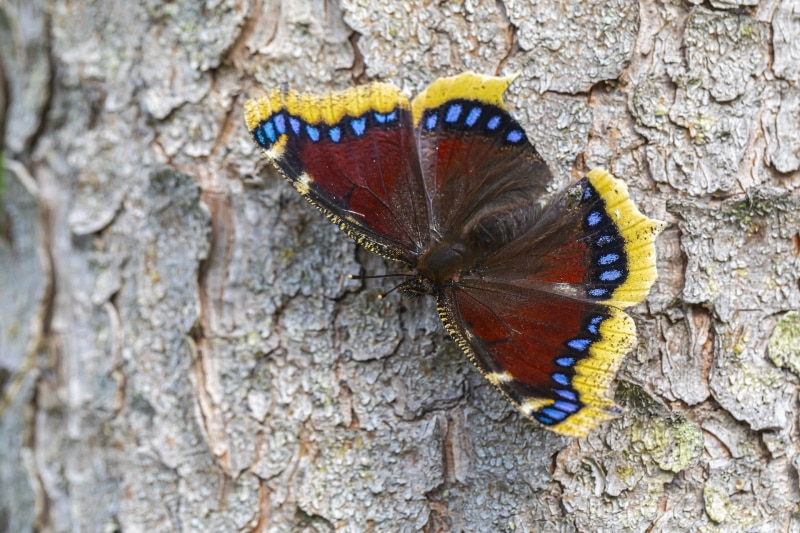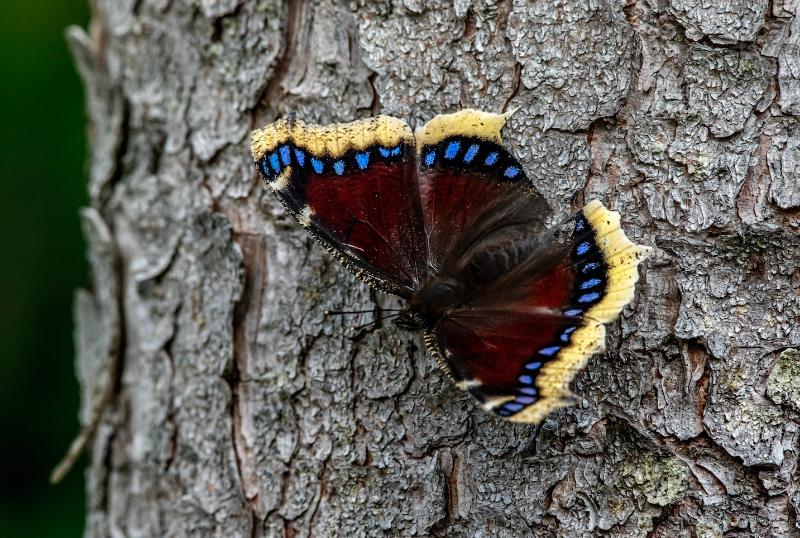What is the State Insect of Montana? Symbolism, Facts, & FAQ
-
Cheryl Regan
- Last updated:

The official state insect and butterfly of Montana is the mourning cloak butterfly, or Nymphalis antiopa. This lovely maroon creature is often one of the first butterflies to emerge at the start of spring, just as the snow begins to melt away.
Keep reading to learn more about the mourning cloak butterfly, and how it was designated Montana’s state insect!

What is the Mourning Cloak Butterfly?
The mourning cloak is a beautiful butterfly with a wingspan of around four inches. Most of its wings are dark, reddish-brown to maroon in color. The wings are edged with bright yellow and iridescent blue spots. The markings of the mourning cloak butterfly make it easily recognizable. Keep an eye out for them at the start of spring, especially on tree trunks where they like to sit and soak up the sun.
Mourning cloaks are part of the Nymphalidae family—also known as brush-footed butterflies, due to their hairy front legs.

How Did the Mourning Cloak Butterfly Get its Name?
Nymphalis antiopa are commonly found across North America and throughout Eurasia. They are known by many names, including Camberwell beauty, grand surprise, and white petticoat. In several European countries with Germanic languages, the common name for this butterfly literally translates to “mourning cloak,” because their maroon patterns resemble the traditional dark-colored cloaks worn by those in mourning.
British entomologist, L. Hugh Newman, likened the butterfly’s patterns to a defiant girl who let a few inches of her brightly colored dress show below her mourning cloak.
How Did the Mourning Cloak Become Montana’s State Insect?
After garden clubs requested that Montana designate a state butterfly—something 19 states at the time had already done—Rep. Jim Whitaker sponsored a bill to make the mourning cloak Montana’s state butterfly.
The mourning cloak’s designation as Montana’s state insect would have been a unanimous decision if it hadn’t been for a slight Grizzlies versus Bobcats controversy. What does college football have to do with insects, you ask?
Well, for Montana House Representative, Brad Newman, the mourning cloak’s blue spots and bright yellow edging closely resembled the colors of Montana State University, the Bobcat’s colors. Newman, who graduated from the University of Montana with a law degree, attributed both his loyalty to the University of Montana (represented by the Grizzlies) and the Bobcat’s then-recent string of losses to his eventual vote against the mourning cloak. He said, “I think that as a matter of legislative policy, we ought to stick with a winner… I’m holding out for a maroon butterfly.”
Luckily for the mourning cloak, however, his colleagues remained unconvinced and in 2001, the mourning cloak officially became Montana’s state butterfly.
What Other Symbols Represent Montana?
Also known as the Treasure State, Big Sky Country, and the Land of Shining Mountains, Montana has several official state symbols.
The western meadowlark is the state bird of Montana, while Bitterroot is the state flower. The grizzly bear is Montana’s official state mammal. As for gemstones, both sapphire and Montana moss agate are recognized as official symbols for Montana.


Wrapping Up
Although California was the first state to select a state insect, 48 out of 50 of the United States now have an officially designated insect. For Montana, the state butterfly, the mourning cloak, is also the state insect.
Mourning cloaks love oak sap and maple sap, and they’re often the first butterflies seen fluttering around in spring. Next time you go for a walk, keep an eye out for a butterfly with rich brown wings and bright yellow edging with blue spots!
Featured Image Credit: Erik Karits, Pixabay
Contents
